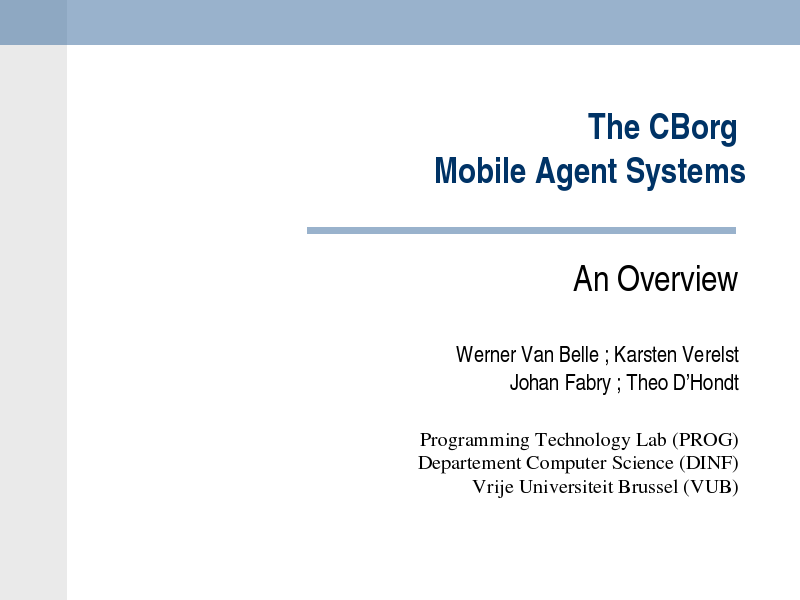| Home | Papers | Reports | Projects | Code Fragments | Dissertations | Presentations | Posters | Proposals | Lectures given | Course notes |
The CBorg Mobile Multi Agent System: An Overview
Werner Van Belle1* - werner@yellowcouch.org, werner.van.belle@gmail.com
Karsten Verelst1 - kaverels@vub.ac.be
Johan Fabry1 - jfabry@dcc.uchile.cl
Theo D'Hondt1 - tjdhondt@vub.ac.be
1- Programming Technology Lab (PROG)
Department of Computer Science (DINF)
Vrije Universiteit Brussel (VUB); Pleinlaan 2; 1050 Brussel; Belgium
* Corresponding author
Abstract : A mobile multi-agent is an active autonomous software component that is able to communicate with other agents; the term mobile refers to the fact that an agent can migrate to other agent systems, thereby carrying its program code and data along. Regarding the expression mobile multi-agent system there is a little confusion. A multi-agent system in AI denotes a software system that simulates the behavior of large groups of interacting agents, without focusing on the distribution aspect of these systems. In the world of distributed computing, a mobile multi-agent system is a distributed environment which multi-agents can be written in. Mobile multi-agent systems can be implemented as a library in an existing language, or as a special state of the art language that has high level primitives to write agents in. Nevertheless, whether one conceives an agent system as a library or as a language, the main goal is the same. A mobile multi-agent system should offer as much flexibility as possible to the agent programmer while hiding the underlying network architecture as much as possible. At PROG we developed a system called CBorg, which is a state of the art mobile multi agent system. The system is build upon Pico , written by Theo D'hondt. The talk will consist of two parts. The first part discusses the use of the system, illustrating the powerful semantics of the Pico language and detailing the current extensions made to create CBorg. These include a location transparent routing mechanism, a number of synchronization primitives and finally strong migration. The second part of the talk will focus on the Pico and CBorg virtual machine. We will explain the necessary requirements for the virtual machine to allow strong migration, give an overview of the routing mechanism and explain what kind of synchronization and concurrency handling mechanism is used. Finally we will discuss our current work on continuations which should nicely glue all these concepts together.
Keywords:
Reference:
Werner Van Belle, Karsten Verelst, Johan Fabry, Theo D'Hondt; The CBorg Mobile Multi Agent System: An Overview; Presented at Ecole des Mines de Nantes; France; June 2000
Files: NantesCBorgOverview.sxi















































































| http://werner.yellowcouch.org/ werner@yellowcouch.org |  |